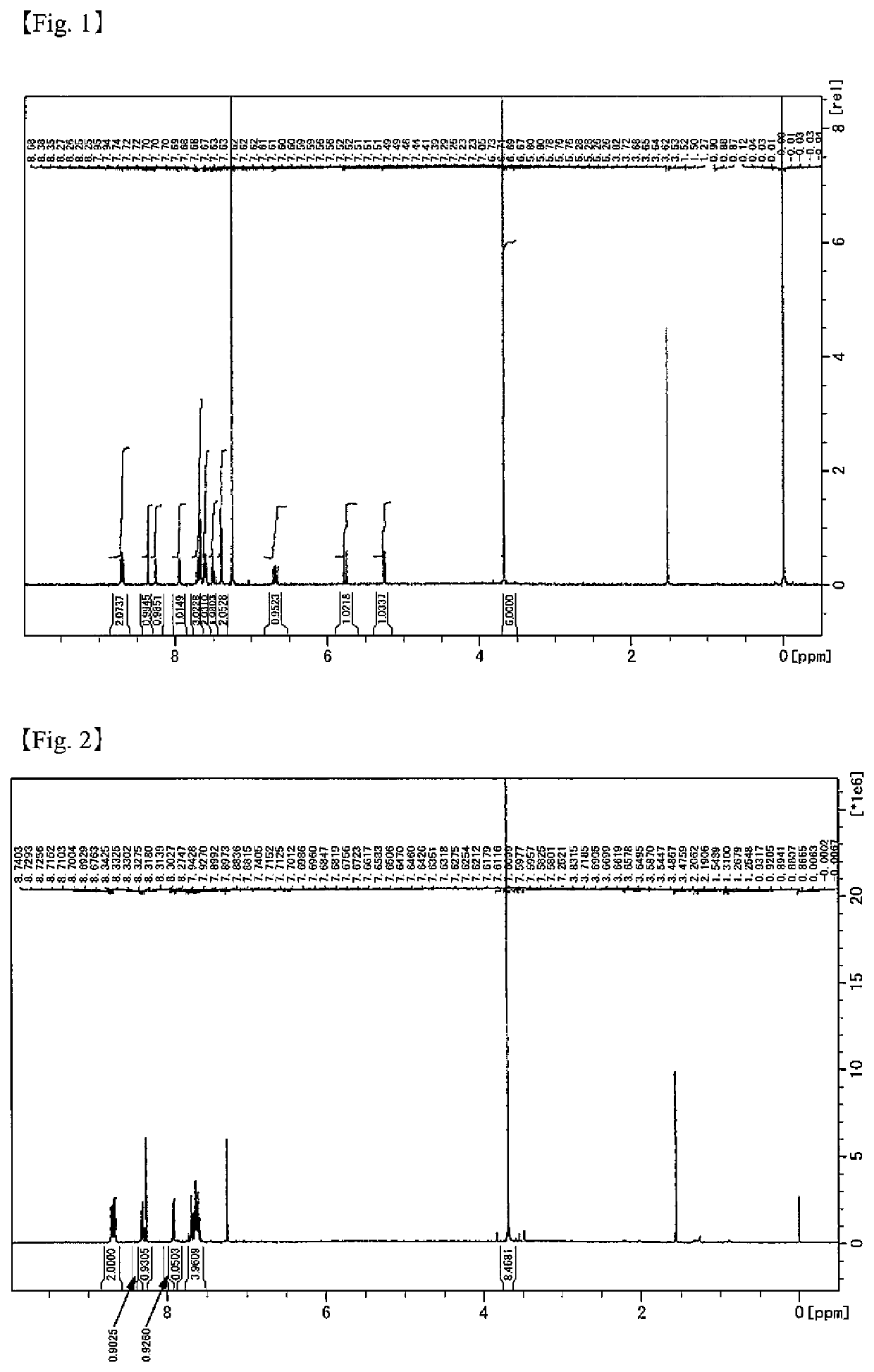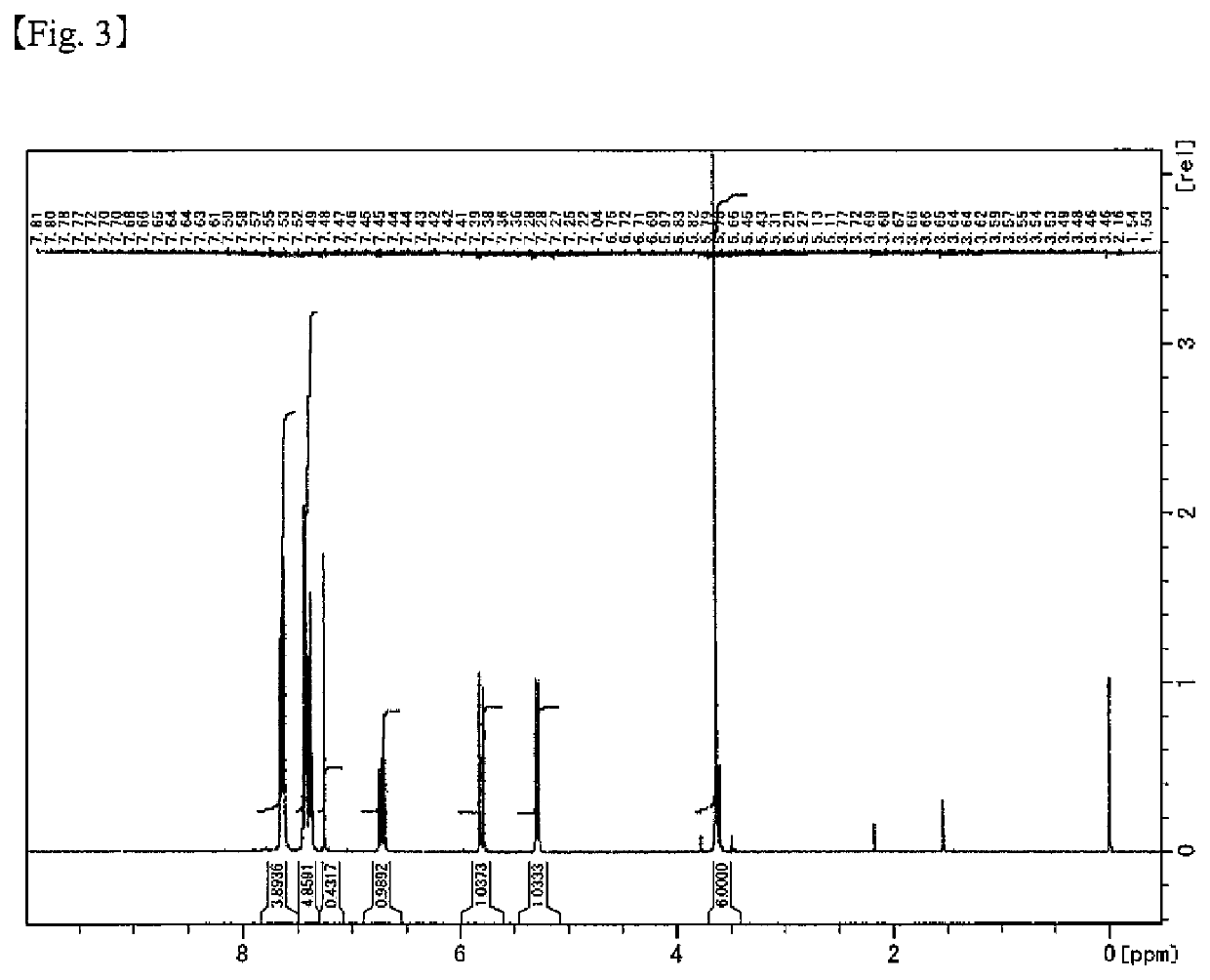Reactive polysiloxane and polymerizable composition comprising same
a polymerizable composition and polysiloxane technology, applied in the field of polymerizable composition comprising a reactive polysiloxane, can solve the problems of white turbidity and difficulty in applying to actual processes, and achieve the effect of high refractive index, efficient production of molded articles, and sufficient handling of viscosity
- Summary
- Abstract
- Description
- Claims
- Application Information
AI Technical Summary
Benefits of technology
Problems solved by technology
Method used
Image
Examples
example 1
[Example 1] Production of Reactive Polysiloxane 1 (XPe10)
[0245]A 50 mL reaction flask equipped with a condenser was charged with 1.36 g (3.23 mmol) of TEAH and 12 g of THF, and the air in the flask was purged with nitrogen using a nitrogen balloon. A mixture of 29.9 g (80.7 mmol) of SPeDMS produced according to Production Example 1 and 24 g of THF was added dropwise thereto at room temperature (approximately 23° C.) over 10 minutes, and the mixture was stirred at 40° C. for 16 hours. This mixture was cooled to room temperature (approximately 23° C.). Subsequently, to this reaction mixture, 6.0 g of a cation-exchange resin [Amberlyst® 15JWET manufactured by The Dow Chemical Company] washed in advance with THF, and 1.2 g of a filter aid [KC Flock W-100GK manufactured by Nippon Paper Industries Co., Ltd.] were added, and the reaction was terminated by stirring for 1 hour. Then, the cation-exchange resin and the filter aid were filtered through a membrane filter having a pore size of 0....
example 2
[Example 2] Production of Reactive Polysiloxane 2 (XPe55)
[0247]A 50 mL reaction flask equipped with a condenser was charged with 0.90 g (2.14 mmol) of TEAH, 0.86 g (47.7 mmol) of ion-exchange water, and 7 g of THF, and the air in the flask was purged with nitrogen using a nitrogen balloon. A mixture of 9.9 g (26.8 mmol) of SPeDMS produced according to Production Example 1, 8.0 g (26.8 mmol) of PheTMS produced according to Production Example 2, and 14 g of THF was added dropwise thereto at room temperature (approximately 23° C.) over 10 minutes, and the mixture was stirred at 40° C. for 16 hours. This mixture was cooled to room temperature (approximately 23° C.). Subsequently, to this reaction mixture, 3.6 g of a cation-exchange resin [Amberlyst® 15JWET manufactured by The Dow Chemical Company] washed in advance with THF, and 0.72 g of a filter aid [KC Flock W-100GK manufactured by Nippon Paper Industries Co., Ltd.] were added, and the reaction was terminated by stirring for 1 hour. ...
example 3
[Example 3] Production of Reactive Polysiloxane 3 (XPe46)
[0249]A 100 mL reaction flask equipped with a condenser was charged with 1.50 g (3.57 mmol) of TEAH, 1.43 g (79.5 mmol) of ion-exchange water, and 12 g of THF, and the air in the flask was purged with nitrogen using a nitrogen balloon. A mixture of 13.2 g (35.6 mmol) of SPeDMS produced according to Production Example 1, 16.0 g (53.6 mmol) of PheTMS produced according to Production Example 2, and 23 g of THF was added dropwise thereto at room temperature (approximately 23° C.) over 10 minutes, and the mixture was stirred at 40° C. for 16 hours. This mixture was cooled to room temperature (approximately 23° C.). Subsequently, to this reaction mixture, 5.9 g of a cation-exchange resin [Amberlyst® 15JWET manufactured by The Dow Chemical Company] washed in advance with THF, and 1.2 g of a filter aid [KC Flock W-100GK manufactured by Nippon Paper Industries Co., Ltd.] were added, and the reaction was terminated by stirring for 1 hou...
PUM
| Property | Measurement | Unit |
|---|---|---|
| Abbe number | aaaaa | aaaaa |
| refractive index | aaaaa | aaaaa |
| transparency | aaaaa | aaaaa |
Abstract
Description
Claims
Application Information
 Login to View More
Login to View More - R&D
- Intellectual Property
- Life Sciences
- Materials
- Tech Scout
- Unparalleled Data Quality
- Higher Quality Content
- 60% Fewer Hallucinations
Browse by: Latest US Patents, China's latest patents, Technical Efficacy Thesaurus, Application Domain, Technology Topic, Popular Technical Reports.
© 2025 PatSnap. All rights reserved.Legal|Privacy policy|Modern Slavery Act Transparency Statement|Sitemap|About US| Contact US: help@patsnap.com



